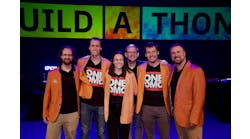A Control Design reader writes: I keep hearing about low-code and no-code development platforms for applications that are being used for machine learning to build algorithms for artificial intelligence. We’re not quite there yet, but the time savings of low-code/no-code has perked up my manager’s ears. How can we use this for machine control? We include some PC-based control, as well as programmable automation controllers. Where do I start, and what do I need to know?
Answers
No coding with visual editors
The use of low-code/no-code (LC/NC) development platforms is rising in manufacturing environments. As advanced technologies in the manufacturing space have come on the scene more rapidly—IIoT, Industry 4.0, machine learning, artificial intelligence and cloud platforms being the most prevalent—integration with plant-floor machine controllers is required. More than ever before, companies are ready to unlock and apply operational efficiencies and move toward a more digitally enabled manufacturing business model.
Implementing these technologies can be simplified with LC/NC development platforms. The strong appeal of LC/NC is in the ability to quickly design a system solution with visual editors. For example, it allows hardware to be easily configured and creates reusable system functions, enabling a modular machine environment. In addition to configurations, LC/NC’s graphical user interface lets you avoid writing even a single line of code, which is usually a necessary task with traditional machine-control devices such as programmable logic controllers (PLC)s, PC-based controllers and programmable automation controllers (PACs) or with platform programming languages.
The best place to start with LC/NC in manufacturing is IIoT-based applications. As manufacturing environments need to respond to customer demand more quickly and efficiently, IIoT is vital to digitalizing the factory floor. In some plants, this means accelerating IIoT solutions for the current and impending needs of running machinery at high usage rates with high frequency in change due to demand. Additionally, IIoT systems need to prioritize security in the connected factory floor while improving productivity, efficiency and COVID-19 guideline compliance. All of this—while maintaining profitability—is doable in an LC/NC environment.
LC/NC platforms are being considered more in manufacturing as they offer an easy, fast alternative to traditional machine-control programming and development processes. They allow a way to implement innovations, such as IIoT, to be realized faster without needing formal coding skills to automate a process and boost the digital transformation of the factory floor.
Aurelio Banda / group vice president automation / Motion / www.motion.com
For translations and transactions
We’ve been helping engineers apply various low-code tools since 2013 and see increasing interest in them as users look to decrease project timelines, increase scalability and bridge siloed systems. These are the areas where we have seen low-code tools excel.
Also read: Automation without programming
However, if you’re interested in low-code tools for machine control, that may be another matter. It can work, but it will depend on the tool that you’re considering and whether that tool is designed for real-time control.
For example, Node-RED, a popular low-code tool, is designed for asynchronous cross-domain communication. This is great for IoT applications where you’re trying to integrate different hardware and software assets. It addresses popular use cases like protocol translation, transactions with databases and network services, visualization, and, yes, even machine learning.
However, while you can also use those capabilities to communicate with PLCs and other field devices, at its core, Node-RED is not designed for real-time, deterministic control. Performance may vary, and you’ll want to consider whether an event-driven programming style could work for your application. Typically, we’ve seen that work best for small-scale, non-critical applications, especially data acquisition and edge data processing.
On the other hand, something like a low-code HMI designer, for example, shouldn’t be a concern since it is purpose-built for machine control. It may not offer all the bells and whistles of a more granular or customizable solution, but it will operate the way you expect and probably save you development time.
As far as how to get started, if time savings is your primary goal, you may want to invest in understanding modular program design and other techniques for increasing code reusability before jumping into low-code/no-code. There’s probably a lot of untapped potential with your existing PC/PAC-based automation.
However, if you’re willing to experiment with different control platforms, industrial edge controllers, I/O modules and gateways often include low-code tooling in addition to more traditional control options, giving you the best of both worlds in the same package.
Benson Hougland / vice president of product strategy / Opto 22 / www.opto22.com
Low-code for legacy replacement
Enterprise-grade low-code platforms help to combine speed and efficiency with the expressiveness and capability of traditional development, enabling companies to build applications quickly and delivering significant productivity gains. These development tools enable organizations of all sizes, regardless of industry, to build software that tackles their most pressing challenges—whether it’s transforming customer experiences, delivering workplace innovation, automating processes or modernizing core systems. Rather than depending on a few elite software developers or purchasing off-the-shelf software-as-a-service (SaaS) tools, businesses can leverage low-code tools to enable their existing teams to build serious applications that fit their exact needs and deliver critical business value.
For example, Vopak, which develops crucial infrastructure solutions for the world’s changing energy and feedstock systems, revamped its entire IT strategy after Oracle’s announcement to sunset support for the legacy software system it relied on. The company built custom Web and mobile applications for both its employees and customers, allowing them to experience an agility boost of four times, which enables its developers to implement changes at the drop of a hat and deliver digital solutions to capitalize on customers’ needs. This is a real-world example of the impact these tools can have on modernizing any organization’s applications and infrastructure to leave legacy systems and technical debt in the past and maximize innovation.
Paulo Rosado / founder and CEO / OutSystems / www.outsystems.com
Device-to-cloud
Low code means you only need to know a little code, and no code means using drag-and-drop items and connecting them in a graphical user interface. These are the platforms that help engineers to start designing apps in minutes with no programming knowledge required.
IoT design is no easy feat, typically involving the integration of a disparate mix of technologies, not to mention the speed of change, which is making it difficult for development teams to stay abreast of new capabilities and advancements. A low-code/no-code platform developed for IoT solutions allows developers to establish device-to-cloud projects with almost zero programming skills required and gets you started with development in minutes. These low-code and no-code platforms have proven to be significant additions to the quick application development toolset.
Ankur Tomar / global solutions development manager / Newark / www.newark.com
Artificial-intelligence toolbox
Up to now, machine learning has belonged to programming engineers that build the neural networks and start the processes. This is becoming much simpler through time, but, again, you need to build the neural network. Enter the world of low-code/no-code development platforms. These products allow companies to utilize people who are not computer engineers with the ability to build artificial-intelligence networks using toolboxes and pictures. There are entire catalogs of choices based on the desired machine control you wish to achieve. It is a very user-friendly approach. Of course, there are a lot of promises, so I would recommend that you research several of these companies before you dive in. Find the one that offers the products that fit your goals and level of employee understanding. Have each organization demonstrate its approach before you make your final decision.
Perry Hudson / key account manager, packaging / Pepperl+Fuchs / www.pepperl-fuchs.com





